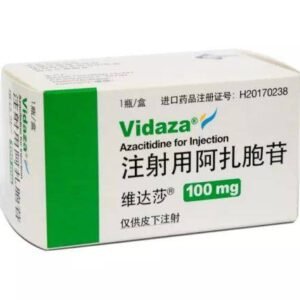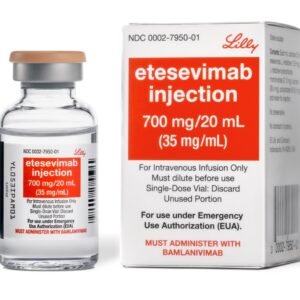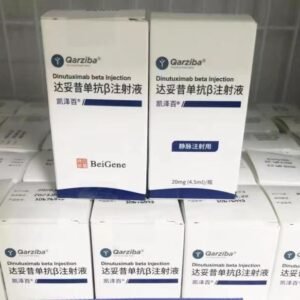Azacitidine for Injection
Effects and efficacy: This product is suitable for intermediate-risk group 2 and high-risk myelodysplastic syndrome (MDS) in the International Prognostic Scoring System (IPSS); it can be used to treat chronic myeloid-monocytic leukemia (CMML); it can be used to treat acute myeloid leukemia (AML) classified by the World Health Organization (WHO), and bone marrow primitive cells of 20%-30% with multilineage dysplasia.
Usage and dosage: Each bottle of this product should be reconstituted with 4mL of sterile water for injection. The diluent should be slowly injected into the vial, and the vial should be shaken or rotated vigorously until a homogeneous suspension is obtained. The suspension is turbid. The suspension should not be filtered after reconstitution, as this operation may filter out the active ingredients. For preparations for immediate subcutaneous administration, doses greater than 4mL should be divided equally into two syringes. The product can be stored at room temperature for up to 1 hour, but must be administered within 1 hour after reconstitution. The reconstituted solution of preparations for delayed subcutaneous administration must be stored in a vial or drawn into a syringe, and doses greater than 4mL should be divided equally into two syringes. After reconstitution, the product must be refrigerated immediately. When the product is reconstituted with unrefrigerated water for injection, the reconstituted solution can be stored under refrigerated conditions (2℃-8℃) for up to 8 hours. When the product is reconstituted with refrigerated (2℃-8℃) water for injection, the reconstituted solution can be stored under refrigerated conditions (2℃-8℃) for up to 22 hours. After being removed from refrigerated conditions, the suspension is allowed to equilibrate to room temperature within 30 minutes before administration. The first treatment cycle For all patients, regardless of baseline hematological laboratory test values, the recommended starting dose for the first treatment cycle is 75mg/m2, administered subcutaneously daily for 7 days. Patients can be given medication to prevent nausea and vomiting. Complete blood counts, liver biochemical indicators, and serum creatinine values should be collected before the first dose. Subsequent treatment cycles are 4 weeks apart. Patients are recommended to receive at least 6 cycles of treatment. However, patients with complete or partial remission may need to increase the treatment cycle. Treatment can be continued as long as the patient continues to benefit. Patients should be monitored for hematological remission and renal toxicity, and if necessary, dosing should be delayed or the dose reduced. Dose adjustment based on hematology laboratory test values: For patients with baseline (treatment start) WBC ≥ 3.0 × 109 / L, ANC ≥ 1.5 × 109 / L, and platelet ≥ 75.0 × 109 / L, based on the lowest count in any treatment cycle, the dose is adjusted as follows: ANC < 0.5 × 109 / L, platelet < 25.0 × 109 / L, the next cycle medication is 50% of the previous cycle. ANC: 0.5-1.5 × 109 / L, platelet < 25.0-50 × 109 / L, the next cycle medication is 67% of the previous cycle. ANC > 1.5 × 109 / L, platelet > 50.0 × 109 / L, the next cycle medication is 100% of the previous cycle. For patients with baseline counts of WBC <3.0×109/L, ANC <1.5×109/L, or platelets <75.0×109/L, dose adjustments should be based on the nadir count and bone marrow biopsy cellularity at the nadir. If the WBC or platelet nadir count decreases by 50-75% relative to baseline; the bone marrow biopsy cellularity at the nadir is 30-60%/15-30%/<15%, the next cycle of medication is 100%/50%/33% of the previous cycle. If the WBC or platelet nadir count decreases by >75% relative to baseline; the bone marrow biopsy cellularity at the nadir is 30-60%/15-30%/<15%, the next cycle of medication is 75%/50%/33% of the previous cycle. Dose adjustment based on serum electrolytes and renal toxicity: If an unexplained decrease in serum bicarbonate levels to <20mEq/L occurs, the dose should be reduced by 50% in the next course of treatment. Similarly, if unexplained high blood urea nitrogen (BUN) or serum creatinine occurs, the next cycle should be delayed until the above laboratory values return to normal or baseline, and the dose of the next course of treatment should be reduced by 50%.
Drug contraindications:
Allergy to this product is contraindicated. Use with caution in case of liver damage. Use with caution during pregnancy and lactation.
Related dosage forms:
Injection
Share:
Products
Our offers
Health Classification
Let us work together to protect precious health






























